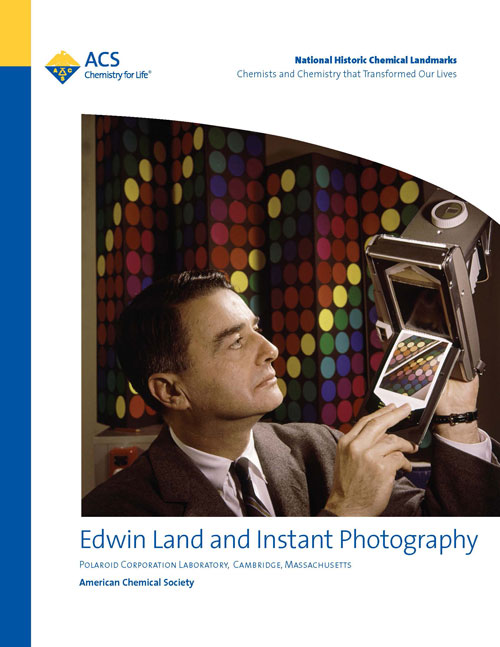Edwin Land and Polaroid Photography
A National Historic Chemical Landmark
Dedicated at the MIT Museum on August 13, 2015, and installed at the former Polaroid Corporation Laboratory in Cambridge, Massachusetts.
Edwin H. Land (1909–1991) was the innovative inventor responsible for conceiving of and perfecting instant photography. Known simply as Polaroid, the system revolutionized traditional photography by compressing darkroom processes into an integrated film unit and producing a final photograph in the seconds following the click of a camera shutter.
Beyond this single remarkable invention, Land produced other transformative technologies such as the sheet polarizer, and he contributed broadly to federal research activities during World War II and the following decades. For his scientific and business achievements, Land was admired by scientists, corporate leaders, and government officials alike.
Contents
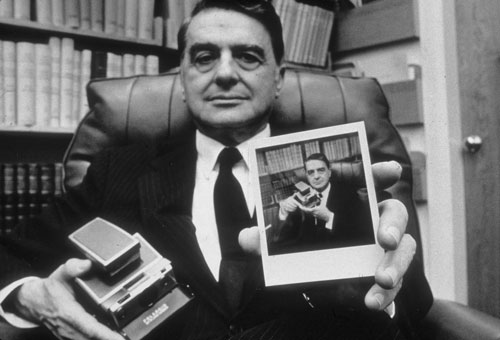
Edwin Land and polarized light
As a boy, Land was fascinated by light. In particular, he was drawn to the natural phenomenon of light polarization.
Polarization refers to a physical property of light waves. As the waves move forward, they vibrate vertically, horizontally, and at all angles in between. A polarizer acts like a slatted screen, with long, thin, parallel openings. These invisible slats stop all angles of light except those parallel to the openings. By doing so, polarizers provide the ability to select light waves with particular orientations.
Natural polarizers were effective at reducing glare and measuring angles of reflectivity, but they were large and expensive. Land imagined important uses for synthetic polarizers, if they could be produced. Almost from the start of his work, around age 13, Land was searching for a product that would improve vehicle safety during nighttime driving: If polarizers could be placed in headlights and windshields, then they could be used to prevent the disturbing glare from oncoming vehicles’ headlights. Moreover, because glare would be eliminated, headlights could be made brighter, thereby increasing the safety of nighttime driving.
In 1926, Land enrolled at Harvard University to study physics, but his desire to conduct research caused him to leave after only a few months in search of more practical opportunities. He moved to New York City, where he studied physical optics independently at the New York Public Library and conducted experiments secretly at Columbia University. There, he worked to develop a synthetic polarizer.
Land’s experiments built on those of the British chemist and surgeon William Herapath (1820–1868). Herapath had sought, with little success, to produce large synthetic crystals that would mimic the natural crystals that were the most useful polarizers available at the time. Land recognized an alternative, and he worked to arrange a mass of microscopic crystals to produce the same effect. He created fine polarizing crystals, suspended them in liquid lacquer, and aligned them using an electromagnet. He then pulled a sheet of celluloid (a thin, clear plastic) through this solution to make a continuous sheet of crystals. As the lacquer dried, the crystals retained their orientation, and the result was a polarizing sheet that was thin, transparent, and pliable.
In 1929, Land applied for his first patent, a method for producing his polarizing sheets. He returned to Harvard in the same year but left again before completing his undergraduate degree to focus on his emerging business. By 1930, Land had identified a more promising way to manufacture polarizing sheets: Instead of using electromagnets, he could apply the tiny crystals to a plastic sheet and, by stretching it, achieve parallel alignment of the crystals. Although it took several years to perfect, this method resulted in the commercial production of polarized sheets.
In 1932, Land and George W. Wheelwright, III (1903–2001), a Harvard colleague, formed Land-Wheelwright Laboratories in Cambridge, Massachusetts, to manufacture polarizers. The company’s inexpensive polarizers were used in photographic filters, glare-free sunglasses, and stereoscopic products that gave the illusion of three-dimensional (3-D) images. 3-D movies were created by applying polarizers to projectors and viewing glasses. The company also invented a new product called a vectograph that combined two still images taken from slightly different positions and printed as oppositely-polarized images; using polarized glasses, viewers saw a 3-D image of the subject.
In 1937, Land-Wheelwright became a public company named Polaroid Corporation after the trade name for the firm’s polarizing films. While Land’s dream of anti-glare vehicle systems was never implemented by automakers, the company was making a good business on polarizing films.
My motto is very personal and may not fit anyone else or any other company. It is: Don't do anything that someone else can do. Don't undertake a project unless it is manifestly important and nearly impossible.
—Edwin H. Land, Forbes magazine, May 4, 1987
Polaroid and World War II research
In 1940, as the United States anticipated its entry into World War II, Land proposed a new task for the young company—to focus its scientific research and manufacturing on technologies that would help to win the impending war. The U.S. entered the war in December of the following year, and Polaroid became one of many companies to contribute to the wartime effort.
Polaroid delivered anti-glare goggles for soldiers and pilots, as well as gun sights, viewfinders, cameras, and numerous other optical devices with polarizing lenses. The vectograph, previously a novelty, became a tool for the U.S. military to visualize geographic features of battlegrounds and aerial maps in three dimensions. Polaroid earned a reputation among the many companies working toward national goals for delivering optical technologies in short time frames.
In addition to leading Polaroid research for military projects, Land also served as a consultant to the National Research Defense Committee, a body that emerged at the onset of WWII to direct non-governmental scientific research for war purposes. In time, Land would continue his government service, working on Cold War technologies and advising presidents on scientific matters.
Around this time, Land played an important role in the synthesis of quinine, the most effective antimalarial medicine then known. Quinine was produced from cinchona, a tropical plant grown primarily in Indonesia. Like other strategic materials that were produced abroad, the U.S. sought methods to synthesize quinine domestically. In 1942, Land hired Robert Burns Woodward (1917–1979) of Harvard University as a Polaroid consultant to find an alternative to the use of quinine in the production of polarizers (quinine-based crystals were used to manufacture polarizers at the time) and also to explore alternative methods for producing quinine.
The first task was quickly completed, and Woodward then developed a plan for synthesizing quinine. Land was convinced of the importance of the project and the merits of Woodward’s proposal. With the help of Polaroid and Harvard, Woodward and his colleague William von Eggers Doering (1917–2011) successfully synthesized quinine in 1944. Although it did not lead to a practical method of production, the synthesis was a milestone in the field of organic chemistry and was among the achievements that earned Woodward the Nobel Prize in Chemistry in 1965.
As WWII drew to a close and the company neared the end of its military service, Land faced a new challenge: What would Polaroid do after the war? Now leading a much larger company with more employees and greater research expertise than a few years earlier, Land was determined to put his company and its people to work during peacetime.
If you sense a deep human need, then you go back to all the basic science. If there is some missing, then you try to do more basic science and applied science until you get it. So you make the system to fulfill that need, rather than starting the other way around, where you have something and wonder what to do with it.”
—Edwin H. Land
Invention of Polaroid instant photography
In 1943, during a vacation in Santa Fe, Land took a photo of his daughter, Jennifer, who was then three years old. The girl asked her father why she couldn’t see the photo right away—at the time, photographs had to be developed professionally, a process that often took several days. Land was immediately taken by the concept of instant photography and set off on a long walk to think through the idea.
Years later, he recalled, “Within an hour, the camera, the film, and the physical chemistry became so clear” that he immediately set off to speak with his patent attorney. Polaroid’s work with crystals, dyes, and polymers in the development of polarized products provided the company the expertise it needed to begin working on the project before the war was over.
The instant photography system Land imagined was a radical departure from traditional film processing. In conventional photography, a photographer took a series of photographs on a roll of film and returned it to a laboratory later for development. There, a technician would work inside a darkroom, a specialized laboratory that contained the materials—chemical baths to start and stop the development, washing and drying equipment, and other supplies—needed to develop film and produce photographic prints. The entire process took several minutes in the laboratory and usually several days from the time a photographer dropped off the film until a print was ready for retrieval.
Land’s system required a new kind of camera and film, a system that would compress all of the components of a conventional darkroom into a single film unit, to be processed in under a minute after being ejected from the camera. If successful, the system would allow users to evaluate and share images moments after they had been taken, a transformational change from traditional photography.
As in traditional photography, light entered the camera through a lens and was reflected onto a light-sensitive film that recorded a negative image of the scene. (In a negative, dark areas of the scene appear light and light areas appear dark.) After the silver halide crystals in the film were exposed to light, they were reduced to metallic silver. From this negative, a positive photograph could be developed.
The key to Land’s system was a film unit that contained both the negative film and a positive receiving sheet joined by a reservoir that held a small amount of chemical reagents (including sodium hydroxide, a strong base) that started and stopped film development. The reservoir, called a pod, was sealed within the film unit, making the entire process appear dry for the consumer even though it used liquid developers. When the film was released from the camera, a pair of rollers at the mouth of the camera bit the pod, rupturing it and allowing reagent to be forced evenly across the film, coating the entire image area. As the reagent spread, various chemicals worked to remove the unexposed silver halide from the negative, release it onto the positive layer at the top of the film unit, and reduce it, producing the final image.
From 1943 through 1946, the instant camera was kept secret at Polaroid’s laboratories as multiple challenges were resolved. The entire process required suitable color intensity and sharpness. The film unit had to be shelf-stable from the time it left the factory to when consumers clicked their camera buttons, and it had to work at a wide variety of temperatures, from desert heat to winter cold. Finally, after development, the unit had to stop all the reactions to create long-lasting photographs. Each problem was solved with precise control of the film’s chemistry.
It was as if all that we had done in learning to make polarizers, the knowledge of plastics, and the properties of viscous liquids, the preparation of microscopic crystals smaller than the wavelength of light, the laminating of plastic sheets, living on the world of colloids in supersaturated solutions, had been a school both for the first day in which I suddenly knew how to make a one-step dry photographic process and for the following three years in which we made the very vivid dream a solid reality.”
—Edwin H. Land
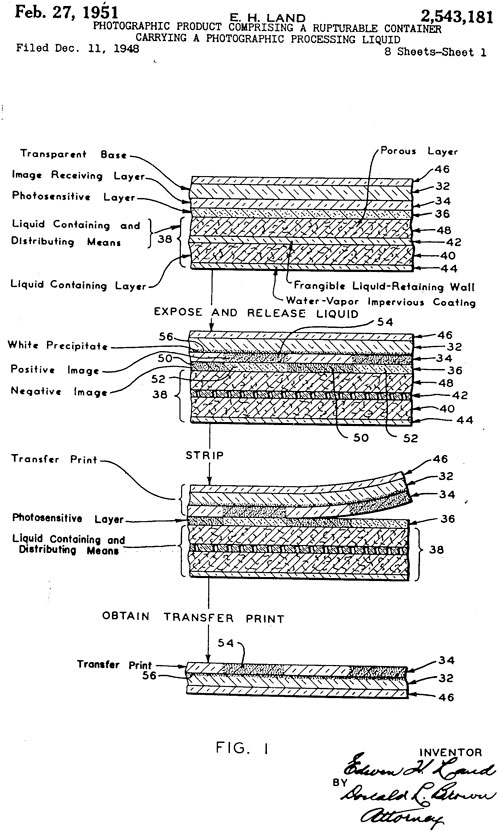
Introduction of instant photographic film
In fewer than five years, Polaroid had invented and mastered all of the necessary new technologies to demonstrate Land’s instant photography system. Land made the first public demonstration of instant photography on February 21, 1947, during a meeting of the Optical Society of America in New York City. Newspapers covering the event called the invention “revolutionary.” The following year was dominated by resolving challenges the company faced in bringing the system from the laboratory to commercial-scale manufacturing.
The first Polaroid camera, called the Model 95, and its associated film went on sale in 1948 at a department store in Boston. The cameras sold out in minutes. The Model 95 produced only sepia-toned images, and after the film emerged from the camera, photographers had to wait exactly 60 seconds before peeling off the negative backing of the image. Although it required precise operation by photographers and did not exceed the quality of traditional films, customers loved the system’s promise of nearly instant results.
A true (non-sepia) black and white version followed in 1950. Meroë Morse (1924–1969), an art history major from Smith College, worked closely with Land to oversee the development of this version of Polaroid films. Moving to black and white involved a separate set of challenges, primarily in stabilizing the developed image. These films required the additional step of manually swabbing the developed image with a polymer coating to prevent darkening of the photograph.
The series of innovations released by Polaroid over the next decade reduced the early problems and improved picture quality remarkably. By 1957, the New York Times called instant photography “equal in tonal range and brilliance to some of the finest prints made by the usual darkroom routine.” Polaroid Corporation grew rapidly as instant photography exploded in popularity.
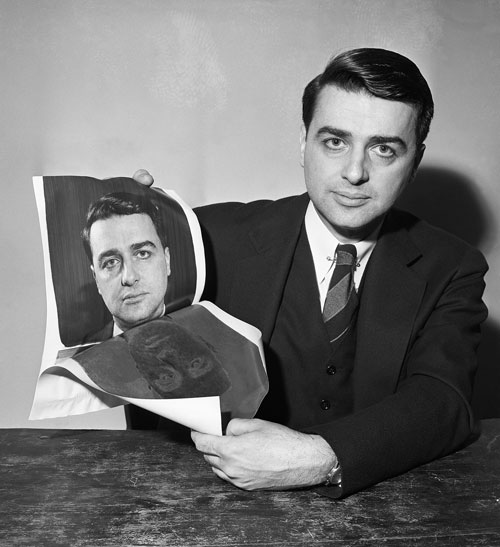
Advancing instant color photography
By the 1960s, traditional photography offered color films to the amateur photographer, and thus the next challenge for Polaroid was to develop instant color film. The project required a tremendous series of chemical breakthroughs, which were accomplished over a span of 15 years. Polaroid scientists had to perfect each component of their version of color photographic film—inventing new dyes, negative films, positive sheets, and developers—and give precise timing to the series of chemical reactions involved in taking and developing a photograph.
More complex than either sepia or black and white photography, color photography used three separate negative layers to record colors. The infinite number of color nuances captured by the human eye can be reproduced by appropriate intensities of three colors—red, green, and blue. They are developed in a photograph using the complementary dyes cyan, magenta, and yellow. Starting in the late 1940s, Land and his team worked with traditional methods for producing color photographs, but they quickly learned to adapt to the thin confines and short timeframes required of Polaroid color photography.
After working on the project for several years, the team found inspiration in a new type of compound proposed by project leader Howard Rogers (1915–1995) that would allow them to completely reformulate the color developing process. Instead of using separate dye and developer molecules for each of the three colors used in film, Rogers proposed, and then led the creation of, new compounds called dye developers in which both components were tethered together. These new molecules served both functions and simplified the overall film unit.
Not only did Polaroid chemists test thousands of new molecules to give adequate colors to their new film, they also orchestrated the series of chemical reactions taking place within the film unit. Each color followed a separate path of development from its negative layer to the positive photographic print. Timing of these molecular movements was crucial for proper color formation. Land maintained his goals of 60-second development with shelf- and temperature-stability and permanence.
By 1962, Polaroid had solved several problems, such as brightening the color dyes and preparing factories for commercial production; however image permanence remained an issue. The alkaline developer molecules, necessary for dissolving the dye developers, transferred with the dyes to the positive layer where they would immediately begin to destroy the final image.
Finally, the team solved the problem by inserting acid molecules within a layer of polymer in the positive sheet where they would react with the alkaline developer molecules the moment after they completed the process of developing the image. When this happened, the acid and base combined, forming water in the film and fixing the dyes in place.
Polaroid’s color film debuted in 1963. Sales of Polaroid film, already rapidly increasing, expanded six-fold in the following decade. For Polaroid, color instant photography represented an enormous commercial and technical success.
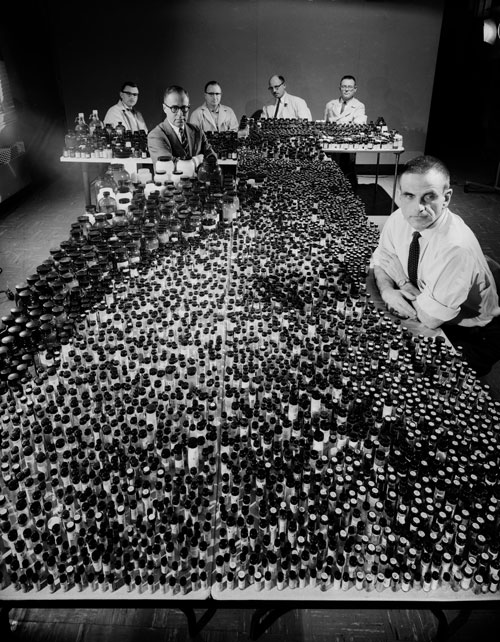

Polaroid SX-70 camera and film
The crowning chapter of the Polaroid system was the development of the SX-70 camera and film. The project represented ultimate simplicity and reward for photographers—all they had to do was press the camera button and watch as the image developed before their eyes.
Until this point, Polaroid films required a step that interfered with Land’s vision of absolute one-step photography: After being ejected from the camera, the user had to peel back the negative sheet to reveal the final photograph. Some early films required additional steps by the user, such as swabbing the developed image with a coating to stabilize it or adhering the image to a hard backing to prevent curling.
The development of the SX-70 and its film required a complete reformulation of the Polaroid system. Above all, the film was integral, meaning that the negative, positive, and developers were all contained within a film unit and would remain there after developing. To accomplish this, the positive layers had to be transparent to allow light to penetrate them and expose the negative, below. Polaroid’s solution was to develop a chemical opacifier—a chemical screen that was clear when undeveloped but opaque immediately when ejected from the camera and able to become clear again to reveal the developed image.
Minimizing the complexity of the undertaking, Land described the project to The Photographic Journal in 1974:
“It is an interesting experience to see how all of Absolute One-Step Photography can happen very simply if it happens sequentially, involving both the camera and film in some two hundred to five hundred steps…
“When the film is ejected potassium hydroxide in a few drops of water is spread in a layer 26/10,000 inch thick and ‘all hell breaks loose,’ but in a much more orderly way than that phrase implies. For several minutes chemical reactions occur rapidly one step after another in that thin sandwich and then this progression slowly stops. There is peace again and the picture is complete.”
The simplicity of the SX-70 system for photographers belied its technical complexity. Within the 2 millimeter thick film unit was a sandwich of thin polymer sheets, a positive image-receiving sheet, reagent, timing and light reflecting layers, and the tri-color negative—17 layers in total. The camera itself was a remarkably sleek design. When it was first sold in 1972, the product represented the culmination of Land’s 1943 dream of absolute instant photography.
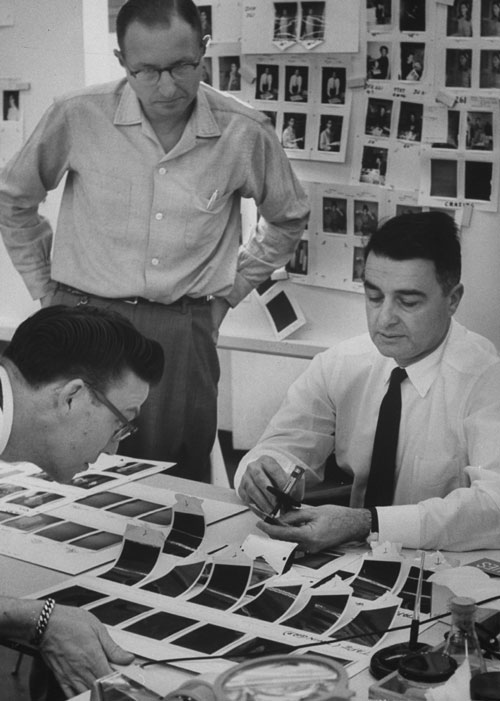
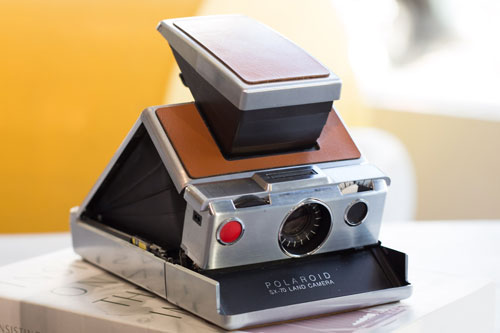
Biography of Edwin H. Land
Edwin Herbert Land was born in Connecticut on May 7, 1909. Beginning in his teenage years, Land was fascinated by science, taking a particular interest in the properties of light. His interests led him to study physics at Harvard University, conduct independent research, and eventually to found his own company, Land-Wheelwright Laboratories, in 1932. Reorganized as Polaroid Corporation in 1937, Land served as its president, chairman, and director of research for several decades.
Land worked closely with arts professionals throughout his career. He hired several art historians to work for the company, believing that the team’s aesthetic abilities were equal in importance to their scientific knowledge. Land also challenged his staff to build films and cameras to the exacting demands of professional artists—Ansel Adams (1902–1984), the legendary landscape photographer, and Marie Cosindas (1925– ), a noted color still life and portrait photographer, consulted on the development of new Polaroid films. Under Land’s leadership, Polaroid successfully bridged ideals in both scientific research and the arts.
In addition to his scientific and business contributions, Land was involved in public service over the course of his life. After his WWII consulting, Land continued as a scientific advisor to the federal government, contributing to the development of cameras for U-2 aerial surveillance system and Corona satellites. Land continued to advise the federal government as a member of the President’s Science Advisory Committee (PSAC) from 1957 to 1959, as a consultant to PSAC from 1960 to 1973, and as a member of the President’s Foreign Intelligence Advisory Board from 1961 to 1977.
Land received numerous service, technology, and scientific awards during his lifetime, including the Presidential Medal of Freedom (1963), the National Medal of Science (1967), and the National Medal of Technology (1988). He served as president of the American Academy of Arts and Sciences from 1951 to 1953 and was a member of the National Academy of Sciences. Although Land never formally completed his undergraduate degree, he was awarded honorary doctoral degrees by several universities.
Land founded The Rowland Institute for Science (now the Rowland Institute at Harvard) to continue his research, primarily on a theory of color vision perception he proposed known as the retinex theory. He retired from Polaroid in 1982, 50 years after founding its predecessor company. Over the course of his career, Land earned 535 patents. He died on March 1, 1991, in Cambridge, Massachusetts.
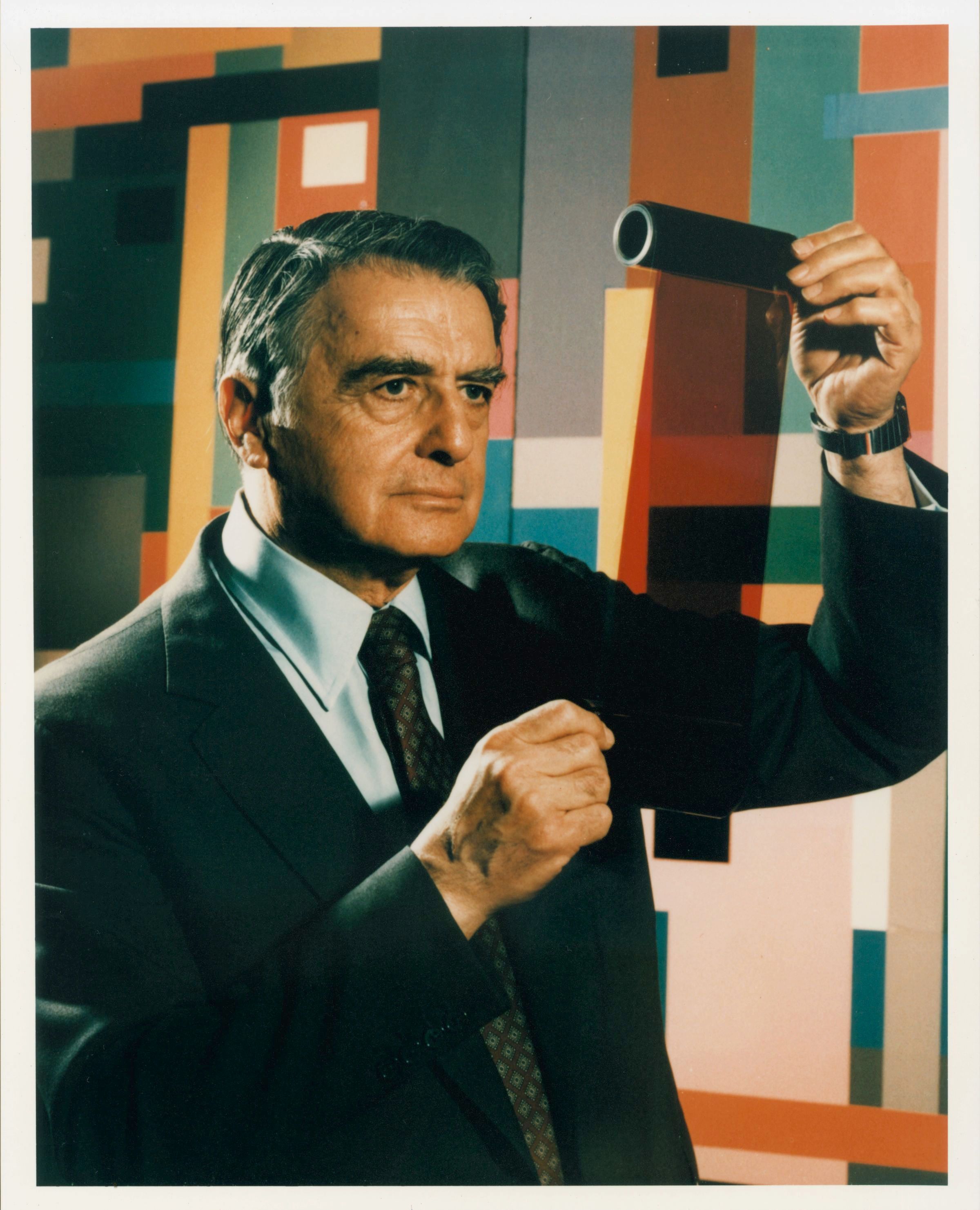
Landmark dedication and acknowledgments
Landmark dedication
The American Chemical Society dedicated Edwin Land and Polaroid instant photography as a National Historic Chemical Landmark in a ceremony at the MIT Museum in Cambridge, Massachusetts, on August 13, 2015.
The commemorative plaque installed at the former Polaroid Corporation Laboratory at Osborn and Main Street, Cambridge, reads
From his workplace in this building, Edwin H. Land (1909–1991) led the Polaroid Corporation in its development of the first instant photography system. This novel technology, demonstrated in 1947, produced photographs by means of a complex sequence of chemical reactions contained within the film unit. Land directed numerous improvements to the original one-step, sepia-toned film until Polaroid introduced a truly integral instant color photography system in 1972. The immediacy of the Polaroid system revolutionized the industry, and instant photography grew rapidly as a popular and artistic medium. Land, an innovative scientist and businessman, earned 535 patents in the course of conducting and directing research at Polaroid.
Acknowledgments
Adapted for the internet from "Edwin Land and Instant Photography," produced by the American Chemical Society's National Historic Chemical Landmarks program in 2015.
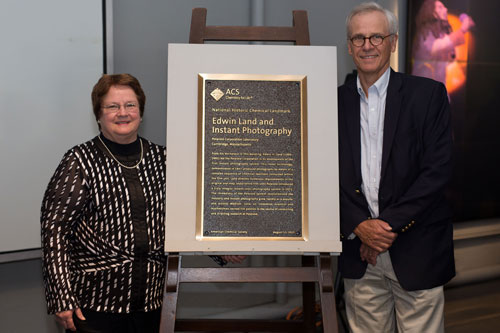
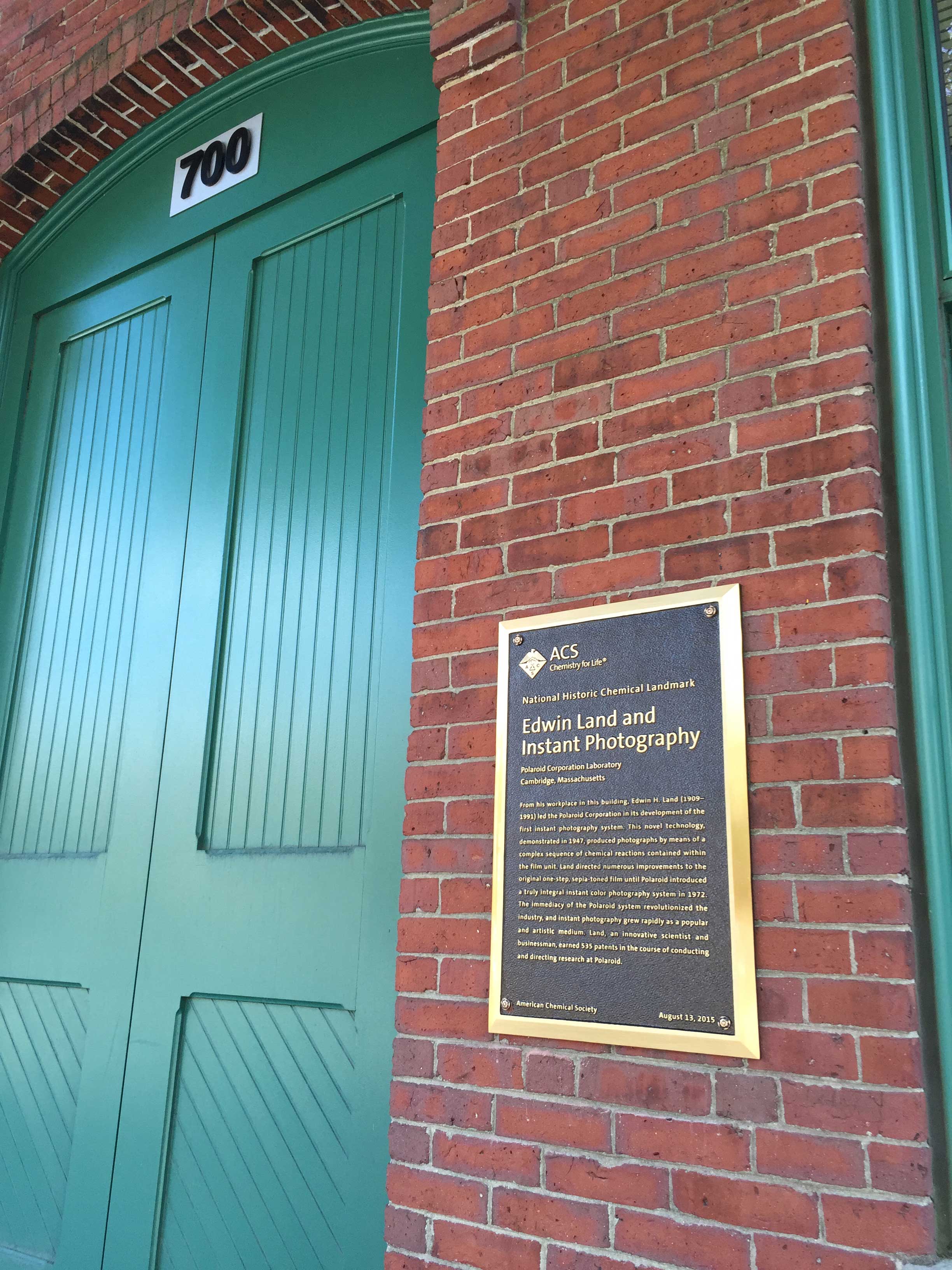
Research resources
Further reading
- Edwin Land and Instant Photography (National Historic Chemical Landmark commemorative booklet; PDF)
- MIT Museum
- Polaroid Corporation History (Polaroid Corporation)
- Edwin H. Land biography (Rowland Institute at Harvard from the Royal Society)
Cite this page
American Chemical Society National Historic Chemical Landmarks. Edwin Land and Polaroid Photography. http://www.acs.org/content/acs/en/education/whatischemistry/landmarks/land-instant-photography.html (accessed Month Day, Year).

